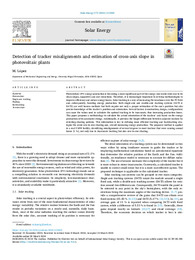Please use this identifier to cite or link to this item:
https://hdl.handle.net/11000/34518Full metadata record
| DC Field | Value | Language |
|---|---|---|
| dc.contributor.author | López García, Miguel | - |
| dc.contributor.other | Departamentos de la UMH::Ingeniería Mecánica y Energía | es_ES |
| dc.date.accessioned | 2025-01-15T19:36:25Z | - |
| dc.date.available | 2025-01-15T19:36:25Z | - |
| dc.date.created | 2024 | - |
| dc.identifier.citation | Solar Energy | es_ES |
| dc.identifier.issn | 1471-1257 | - |
| dc.identifier.issn | 0038-092X | - |
| dc.identifier.uri | https://hdl.handle.net/11000/34518 | - |
| dc.description.abstract | Photovoltaic (PV) energy production is becoming a more significant part of the energy mix world-wide due to its clean origin, supportive and cost reductions. Therefore, it is increasingly important to develop methodologies to improve efficiency and reduce energy losses. Solar tracking is a way of increasing the irradiance over the PV field and, subsequently, boosting energy production. Both single-axis and double-axis tracking systems (SATS & DATS) are well known methods but both require not only a proper estimation of the sun’s position but also precise knowledge of the tracker’s position and orientation. Several factors (construction, design, configuration) can cause the values used to calculate the optimal tracking to be inaccurate, thus increasing production losses. This paper proposes a methodology to calculate the actual orientation of the trackers’ axis based on the energy production of its associated strings. Additionally, it provides the height differences between adjacent trackers by detecting shading patterns. This information is key to defining more efficient tracking and backtracking strategies the avoid row-to-row shading and, overall increasing energy production. The proposed method is applied to a real 5 MW facility, identifying misalignments of several degrees in most trackers that were causing annual losses (1 %), not only due to inaccurate tracking but also row-to-row shading. | es_ES |
| dc.format | application/pdf | es_ES |
| dc.format.extent | 10 | es_ES |
| dc.language.iso | eng | es_ES |
| dc.publisher | Elsevier | es_ES |
| dc.relation.ispartofseries | 272 | es_ES |
| dc.rights | info:eu-repo/semantics/openAccess | es_ES |
| dc.rights | Attribution-NonCommercial-NoDerivatives 4.0 Internacional | * |
| dc.rights.uri | http://creativecommons.org/licenses/by-nc-nd/4.0/ | * |
| dc.subject | Photovoltaic | es_ES |
| dc.subject | Single-axis tracking | es_ES |
| dc.subject | Shading | es_ES |
| dc.subject | Backtracking | es_ES |
| dc.subject | Terrain slope | es_ES |
| dc.subject.other | CDU::6 - Ciencias aplicadas::62 - Ingeniería. Tecnología::621 - Ingeniería mecánica en general. Tecnología nuclear. Electrotecnia. Maquinaria | es_ES |
| dc.title | Detection of tracker misalignments and estimation of cross-axis slope in photovoltaic plants | es_ES |
| dc.type | info:eu-repo/semantics/article | es_ES |
| dc.relation.publisherversion | https://doi.org/10.1016/j.solener.2024.112490 | es_ES |

View/Open:
1-s2.0-S0038092X24001841-main.pdf
4,8 MB
Adobe PDF
Share:
.png)
